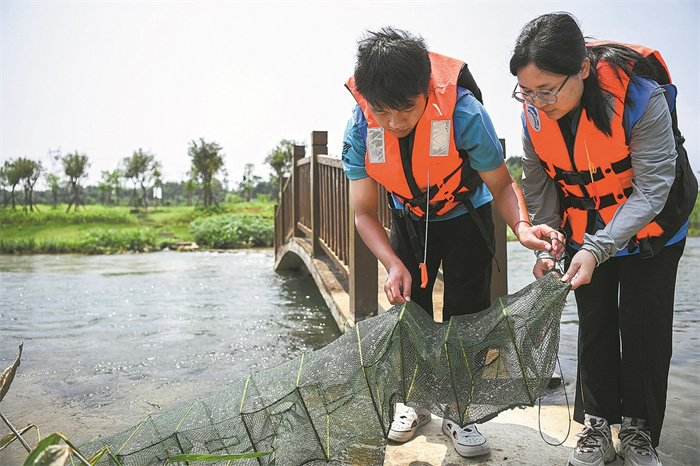Conservation protects fish stocks in Guangxi

Conservation workers recycle a cage net used to monitor the types and quantities of migrating fish in one of the two fish ladders at the Datengxia Gorge Water Conservancy Hydropower Project in Guiping, Guangxi Zhuang autonomous region, in May last year. CAO YIMING/XINHUA
"While enhancing the management of water resources and the control of water-related disasters to benefit mankind, the construction of the Datengxia project has also fully considered the overall natural environment and the reproduction and thriving of aquatic organisms such as fish," said Deng Xunfa, chairman of the Datengxia company.
He said the company chose to not follow a proposal to build a high dam for the project, considering that such a dam would have had a significant adverse impact on the area's natural environment.
Launched in 2014, the project is a crucial part of the country's water network to control floods, facilitate shipping, generate electricity, provide irrigation and enhance the water supply. Its main structure was completed in September.
The Datengxia Reservoir has significantly enhanced the flood control capability of the city of Wuzhou, an industrial hub in Guangxi. After flowing past Datengxia, the Qianjiang joins the Yujiang River in urban Guiping, becomes the Xunjiang River, runs for more than 150 kilometers and passes through Wuzhou.
The joint operation of the Datengxia Reservoir and other reservoirs upstream will enable the city with a population of over 2.8 million to withstand once-in-100-year floods. Previously, Wuzhou was only capable of coping with a once-in-50-year deluge.
Thanks to the project, the Qianjiang can accommodate ships of up to 3,000 metric tons, compared with only 300 tons before the project was completed, the company said.
Aside from addressing the threat of drought for 80,400 hectares of farmland, and water shortage for almost 1.4 million people, the project can generate more than 6 billion kilowatt-hours of electricity annually, which is equivalent to negating the use of 2 million tons of standard coal, reducing emissions of carbon dioxide by 5 million tons.
Because of the Datengxia project's huge store of water, it can release freshwater at a greater speed to combat saltwater intrusion in the Pearl River estuary, which threatens the water supply in the Guangdong-Hong Kong-Macao Greater Bay Area. The time it takes to divert the water for this task has been reduced from seven to 10 days, to only two to three days.
According to Zhang, the construction of the Hongshui center was entirely funded by the Datengxia company. Its operating costs are covered by all 10 of the cascade hydropower plants along the Hongshui-Qianjiang, of which the Datengxia project is the farthest downstream, as well as the Changzhou hydropower station just a dozen kilometers upstream of urban Wuzhou.
